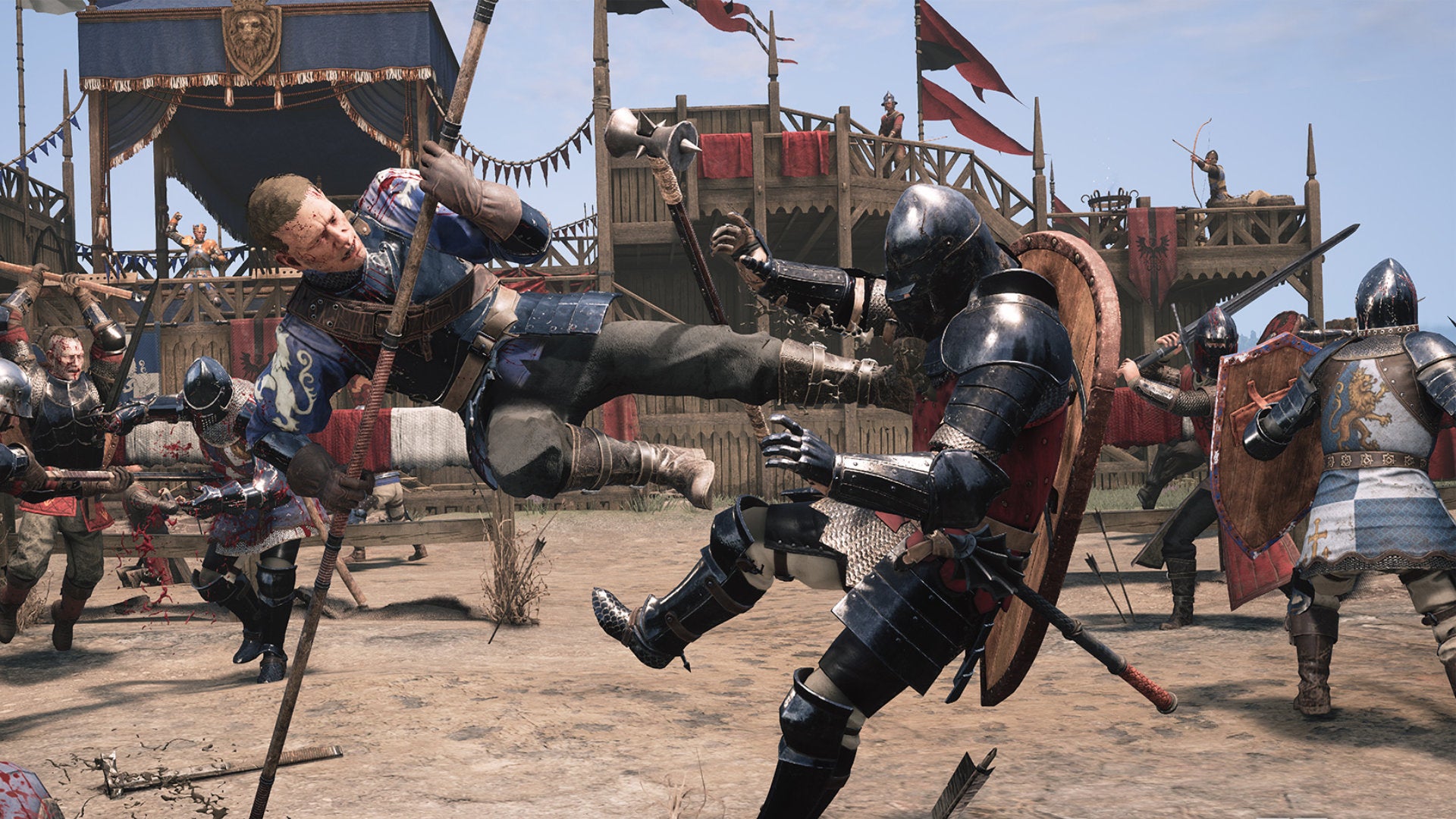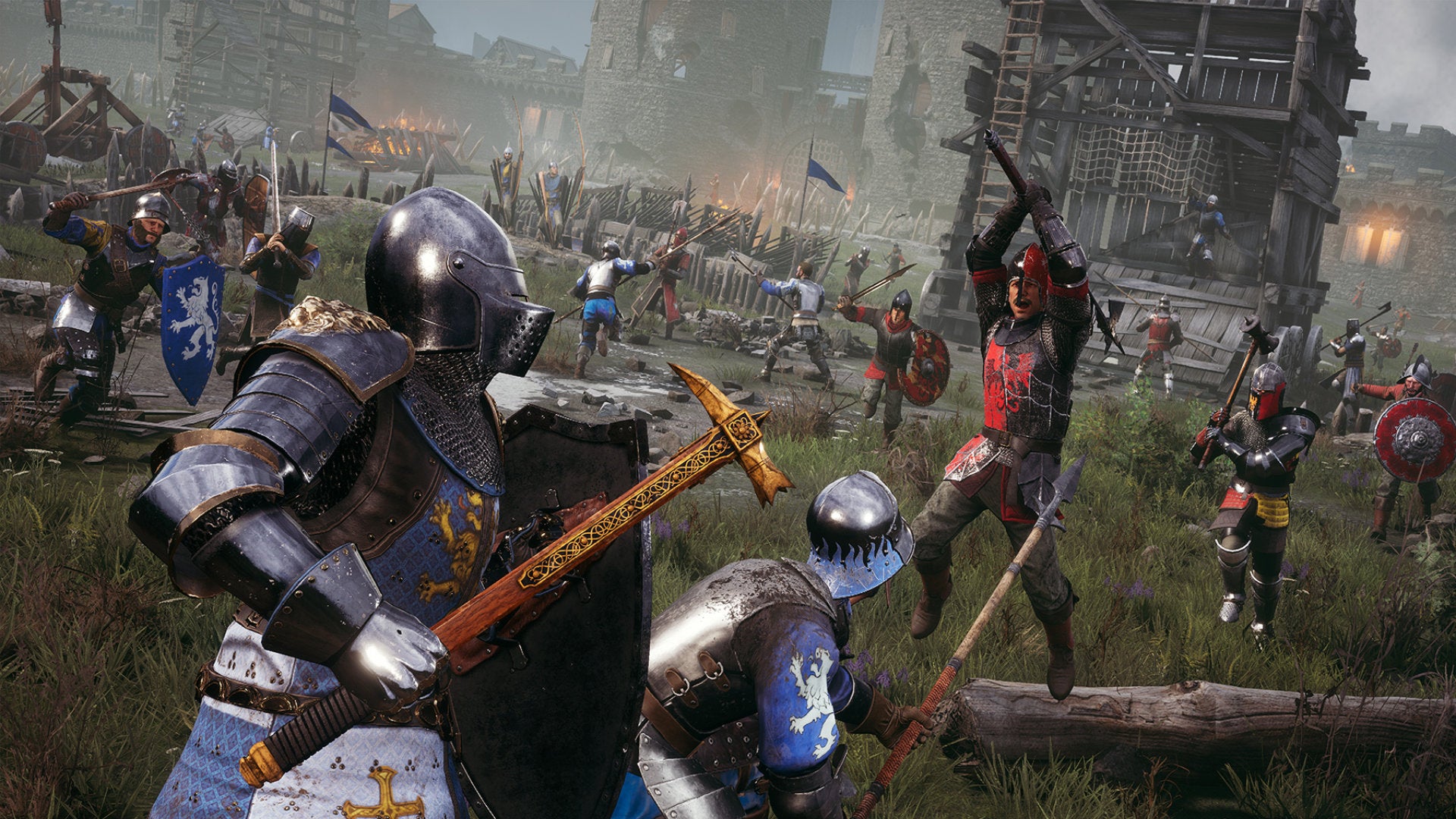Below I’ll take you through various practical tips and tricks on how to win fights in Chivalry 2, both 1vX and 1v1. This is a great walkthrough for players who know the basics (i.e. have completed the tutorial) but want to know what it takes to be like those veterans who seem invincible while cutting down half the enemy team on their own. On this page:
Tips on how to win 1vX fights Tips on how to win 1v1 fights General tips and tricks
Chivalry 2 tips: how to win 1vX fights
Above is a video compilation of myself in various 1vX situations. 1vX is shorthand for “fighting while outnumbered”. It’s very hard to stay alive in 1vX fights, but by using the below tips you’ll be able to win even against 5 or 6 enemies all fighting you at once. I’m almost always top of the leaderboard in Team Deathmatch and Team Objective matches in Chivalry 2, and it’s largely thanks to my strength in 1vX situations. I don’t always manage to stay alive, and I showcase some of these “losses” in the above video too; but the important thing is to kill as many as possible before you die. Killing just two enemies means you’re net positive.
Use third-person perspective
Look, I understand that a big part of the enjoyment of Chivalry 2 is the roleplay element, and first-person perspective obviously suits that better. But for the clearest idea of what’s happening all around you, you need third-person. It’s much easier to win 1vX fights in third-person than first-person, so give it a proper try.
Stay on the outside of the group at all costs
Even the best player in the world will quickly get cut down if they are totally surrounded by enemies with no way out. That’s why it’s so important to stay on the move in 1vX fights. Keep on the outside of the group. If you cut down an enemy on the edge, move into their space. Do whatever you can to stop enemies approaching you from opposite sides.
Attack the enemy who least expects it
In a 1vX situation, the latter side is often emboldened, and therefore reckless. Even experienced players feel like they don’t need to block, they just need to attack and attack until the lone fighter is dead. Good players know how to use this to their advantage in 1vXs by constantly target-switching. Block one player’s attack, and then redirect your counterattack to someone else who was busily winding up their swing. Because of hyper-armour (after riposting or countering, you will auto-block any attack that you’re looking directly at for a short time), redirects such as this are fairly safe and very powerful. And what’s more, dealing a truckload of damage to an enemy makes them more cautious, giving you more room to go on the offensive.
You’ll never win by just blocking
You must, must, must be aggressive in 1vX situations. Don’t just block hit after hit because your stamina will deplete, and you’ll be disarmed and killed in short order. Countering and landing hits replenishes your stamina; this is why I am able to fight for so long repeatedly in the above video. You’re not as defenceless in a 1vX as you think. Again, thanks to hyper-armour, you have plenty of opportunities to attack and cut down multiple enemies at once, particularly if you have a big two-handed weapon like the Messer or Executioner’s Axe.
Good footwork and dodging helps
Going back to the idea of always staying on the edge of the group: good footwork and dodging are both just as important as blocking. Several times in the above video you’ll see me using footwork to get around the blocks of multiple enemies at once, which is often what allows me those huge hit that kill several enemies simultaneously. Another example is at the very end, when I dodge to the side just before the Maul-wielding enemy’s special attack. I predicted the attack would come, I dodged, and therefore I didn’t need to block anything. Instead, I attacked, and dealt massive damage to both enemies. It’s all about footwork.
How to win 1v1 fights
Now let’s talk in more detail about 1v1 duels and how to beat a player who understands the combat of Chivalry 2. The most important thing is to stay unpredictable, and these tips are going to help greatly with that.
Crouch to get under the enemy’s block
In Chivalry 2, you have to look where the enemy’s attack will land in order to block it. You don’t just automatically block by holding the block button and facing the enemy - and shrewd enemies will take advantage of players who do this by crouching and swinging at the waist or legs to get under your block, while simultaneously making themselves a smaller target and potentially ducking out of sight for a moment. It’s a powerful technique that you should practice whenever you’re in a 1v1.
Kick players who like blocking
Kicking is the antidote to shield-users, players who like to hold block, and players who are too predictable with their timings. A kick won’t interrupt an attack, so you should only use it when you know the enemy will be blocking; but it cannot be blocked, and when it lands it’ll temporarily stun the enemy and leave them open to a proper attack (as long as it’s not too slow a windup). Kicking is the gateway tool to the upper echelons of skill in Chivalry 2. You can punish newer players who don’t understand that you can’t block kicks, but it’s also tremendously powerful when you feint from a slash into a kick, because it tricks the opponent into blocking, allowing the kick to land successfully.
Mix up your drags and accels
A “drag” is when you turn your player against the direction of your swing, so that the wind-up phase of your attack lasts longer. An “accel” is the opposite: you turn in the direction of the swing, so the attack lands faster. Both are fantastic tools in their own right for disrupting the timing of your enemy, but they’re best used interspersed with each other. Overusing just one or the other makes you predictable, and you need to avoid that.
Don’t overuse feints and morphs
In a similar vein, feinting and morphing from one attack to another is a very effective tool for wrongfooting an opponent, but it’s easily overused, and even a newer player can effectively counter overuse of feints and morphs by just continuously attacking, because they know their attacks will land first. The most effective feint is the one that is surrounded by regular attacks.
Break out of rhythms with jabs and kicks
Kicks and jabs are both very important tools for breaking up the rhythm of a 1v1. The most obvious rhythm that most newer players get into in a 1v1 is: attack, block, riposte, block, riposte, block, riposte, and so on. Throw in either a jab or a kick to disrupt the tempo and land an unexpected hit afterwards. It’s very important to understand the differences between kicks and jabs, and when to use each. A kick, as I’ve mentioned, doesn’t interrupt attacks, but it cannot be blocked. A jab, by contrast, can be blocked, but it interrupts attacks. Basically: kick people who are blocking, and jab people who are winding up big attacks.
General Chivalry 2 tips and tricks
Finally, let’s finish up with some more general Chivalry 2 tips and tricks for winning matches and staying alive.
Restock points give you another bandage. You can find these restock points scattered about each Team Objective map, and interacting with them will replenish all your throwables as well as your bandage. Throw away all your throwables to see where restock points are. This is harder for archers because you’ll need to run yourself out of ammo - but for other classes, just throw any throwable weapons you have, such as throwing knives and mallets, and an icon will appear above every nearby restock point. Don’t neglect the objectives in Team Objective matches. This is the most common and heinous sin of newer Chivalry 2 players: they throw themselves into fights and completely forget that there’s a task that needs doing. Spend some time learning exactly what needs to be done in each phase of each Team Objective match. Playing in offline mode with bots is a great way to learn this. In Xv1 situations, always assume you’re the target. Don’t play like a fool just because you have allies backing you up. As I said above, a powerful technique of the lone player fighting many is to redirect your attacks towards the person who least expects it. So, expect it. Your special items are powerful tools. The Trumpet, Oil Pot, Bandage Kit, and Banner are all extremely powerful tools when used correctly. Learn the complexities of them one at a time: for instance, don’t Trumpet right after your ally has already used theirs, because the effect doesn’t stack. Another example: place a Banner next to a post that’s part of the map and therefore cannot be broken, and it’ll be harder for enemies to chop the Banner down. Throw your weapon if you have another spare. Particularly with large two-handed weapons, the throw animation can look a lot like a normal overhead attack animation and so it can be pretty hard to see coming. If you’re in a 1v1 and the enemy is bloody and weak and attempting to keep their distance from you so they can heal, throw your weapon at them. It’ll almost always take them by surprise. I’ve killed so many enemies doing this.
Alright, hopefully the above tips have given you a better idea of what you need to do to improve your combat skill in Chivalry 2, both in 1v1 and 1vX fights. While you’re here, be sure to check out our guides to the best weapons to use and the best classes and subclasses in Chivalry 2.

